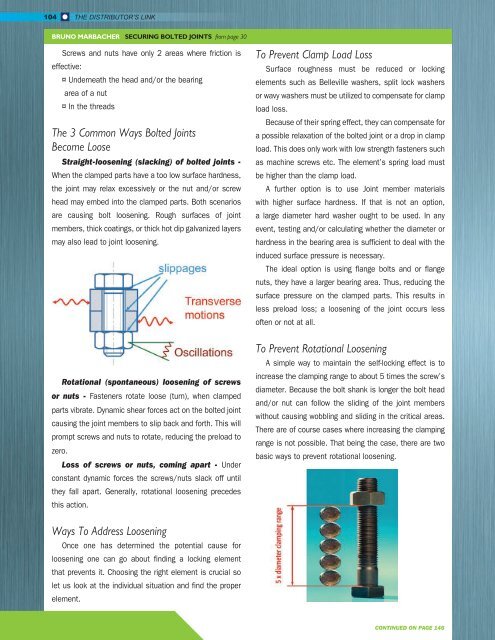WINTER 2024
Distributor's Link Magazine Winter 2024 / Vol 47 No 1
Distributor's Link Magazine Winter 2024 / Vol 47 No 1
Create successful ePaper yourself
Turn your PDF publications into a flip-book with our unique Google optimized e-Paper software.
104<br />
THE DISTRIBUTOR’S LINK<br />
BRUNO MARBACHER SECURING BOLTED JOINTS from page 30<br />
Screws and nuts have only 2 areas where friction is<br />
effective:<br />
¤ Underneath the head and/or the bearing<br />
area of a nut<br />
¤ In the threads<br />
The 3 Common Ways Bolted Joints<br />
Become Loose<br />
Straight-loosening (slacking) of bolted joints -<br />
When the clamped parts have a too low surface hardness,<br />
the joint may relax excessively or the nut and/or screw<br />
head may embed into the clamped parts. Both scenarios<br />
are causing bolt loosening. Rough surfaces of joint<br />
members, thick coatings, or thick hot dip galvanized layers<br />
may also lead to joint loosening.<br />
To Prevent Clamp Load Loss<br />
Surface roughness must be reduced or locking<br />
elements such as Belleville washers, split lock washers<br />
or wavy washers must be utilized to compensate for clamp<br />
load loss.<br />
Because of their spring effect, they can compensate for<br />
a possible relaxation of the bolted joint or a drop in clamp<br />
load. This does only work with low strength fasteners such<br />
as machine screws etc. The element’s spring load must<br />
be higher than the clamp load.<br />
A further option is to use Joint member materials<br />
with higher surface hardness. If that is not an option,<br />
a large diameter hard washer ought to be used. In any<br />
event, testing and/or calculating whether the diameter or<br />
hardness in the bearing area is sufficient to deal with the<br />
induced surface pressure is necessary.<br />
The ideal option is using flange bolts and or flange<br />
nuts, they have a larger bearing area. Thus, reducing the<br />
surface pressure on the clamped parts. This results in<br />
less preload loss; a loosening of the joint occurs less<br />
often or not at all.<br />
Rotational (spontaneous) loosening of screws<br />
or nuts - Fasteners rotate loose (turn), when clamped<br />
parts vibrate. Dynamic shear forces act on the bolted joint<br />
causing the joint members to slip back and forth. This will<br />
prompt screws and nuts to rotate, reducing the preload to<br />
zero.<br />
Loss of screws or nuts, coming apart - Under<br />
constant dynamic forces the screws/nuts slack off until<br />
they fall apart. Generally, rotational loosening precedes<br />
this action.<br />
To Prevent Rotational Loosening<br />
A simple way to maintain the self-locking effect is to<br />
increase the clamping range to about 5 times the screw’s<br />
diameter. Because the bolt shank is longer the bolt head<br />
and/or nut can follow the sliding of the joint members<br />
without causing wobbling and sliding in the critical areas.<br />
There are of course cases where increasing the clamping<br />
range is not possible. That being the case, there are two<br />
basic ways to prevent rotational loosening.<br />
Ways To Address Loosening<br />
Once one has determined the potential cause for<br />
loosening one can go about finding a locking element<br />
that prevents it. Choosing the right element is crucial so<br />
let us look at the individual situation and find the proper<br />
element.<br />
CONTINUED ON PAGE 146
















